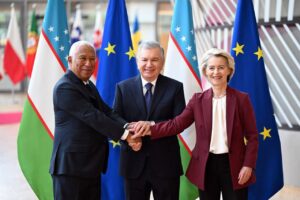Shavkat Mirziyoyev chairs meeting on issues of land resources

Tashkent, The Gulf Observer: Today, President Shavkat Mirziyoyev chaired a meeting on the issues of rational use of land resources, maintaining land records, and improving the quality of cadastre services.
Economic growth, food security, jobs, and regional investment depend not least on land resources. Over the past three years, 40 million hectares, or 90 percent of all land in the country, have been registered with a cadastre due to digitalization.
At the same time, the market value of 44 million 800 thousand hectares of land and 8 million 300 thousand buildings and structures has not been assessed. The conditional cadastral value of existing buildings and structures is $70 billion. Their real market value can be at least 4-5 times higher. Considering the market value of the land, they are a significant economic asset.
Through aerial photography and modern drones, ample untapped land resources are being identified. For example, in Karshi district, where 45 thousand hectares are listed as cropland, it was revealed that 5.1 thousand hectares indicated as pastures are also irrigated land. And these are lost budget revenues, jobs, and incomes.
In general, documents confirming the right to 286 thousand hectares of agricultural land are incomplete. The legal status of 460 thousand hectares of land allocated for permanent use is unclear. The documented area of 159 thousand hectares and the actual one differs.
As a result, over 900 thousand hectares of agricultural land have not been registered for cadastral registration. Due to the lack of a cadastre, it is officially impossible to lease these lands for secondary lease for growing secondary crops. As a result, at least 300 thousand jobs, products from re-crops, and informal rentals remain unaccounted for.
In this regard, the task was set to study the efficiency of using such lands. If farmers effectively use the land, a lease agreement will be concluded with them, and the plots will be registered in the cadastre. Land that is used irrationally will be returned to the hokimiyats’ reserve.
The responsible ministries have been instructed to put this system into practice, carry out aerial photography next year, and complete the cadastre of agricultural land.
During a trip to Surkhandarya region last week, the Head of state noted the possibilities of growing export-oriented types of vegetables. Many people in the regions want to become engaged in this.
In this regard, a decision was made to allocate at least 100 hectares of free land in each district to cultivate export-oriented vegetables. Presentations will be held on growing methods, and producers will undergo training at a “farmer school”. Guaranteed delivery of productive seeds will be established. The sown lands will be sold at auction with the right to lease to those who know their business and have experience in exporting.
At the meeting, attention was paid to the issue of proper land accounting.
Today, 817 thousand hectares of land have turned into populated and industrial zones, but in the reports, their category is indicated as agricultural land. The Agency for Cadastre and hokims were instructed to eliminate these uncertainties and correctly reflect the actual land balance in the reports.
There is also a lot of unregistered land in the water sector. The way to get additional economic benefits is to cover them with the cadastre fully. In short, this will be another reserve for jobs and food.
The task was set to document the lands along canals and collectors, near natural lakes and rivers, and transfer them to the population for growing export crops.
There are no documents on individual internal roads and adjacent lands in the road sector. For example, in Karakalpakstan and Khorezm, more than 2.7 thousand vacant plots have been identified that can be auctioned after the cadastral registration of internal roads. Therefore, in parallel with the repair of internal roads next year, it is planned to prepare their cadastre within the framework of the “Participatory Budgeting” and “My Road” projects.
The issue of efficient land use was analyzed in detail at the meeting.
Over the past five years, 42.5 thousand hectares have been withdrawn from agriculture and transferred to residential and industrial lands. However, the hokims of some regions, districts, and cities cannot use them effectively. In particular, 17.5 thousand hectares of land in 100 districts, the category of which was changed, were neither transferred to entrepreneurs nor put up for auction. There are also empty lots in industrial zones. As a result, the budget lost billions of sums in revenue.
The hokims were warned of the need to speed up work in this direction.
Training personnel for the cadastre field and improving their skills are also essential tasks. Today, the quality of training specialists is not at the proper level. Some faculties and departments were opened inappropriately, and educational programs lag behind the times.
In this regard, the need to organize modern laboratories and provide universities with new educational literature and qualified specialists from abroad was emphasized.
Following the meeting, the state of executive discipline in ministries, hokimiyats, and departments was touched upon.
“We are carrying out large-scale reforms towards the construction of New Uzbekistan. No industry is left out of sight. But reforms should not remain on paper. Heads of ministries and industries, hokims are obliged to ensure their unconditional implementation”, the President said.
It was noted that some managers, in pursuit of numbers, forget about quality, efficiency, and rigor. Strict instructions were given to ensure executive discipline and adhere to the deadlines of all programs, action plans, and projects.
Information from responsible persons was heard on the issues discussed at the meeting.


